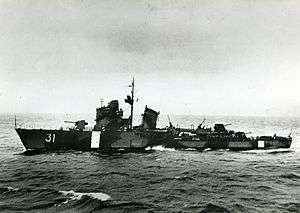HSwMS Munin (31)
 HSwMS Munin | |
| History | |
|---|---|
| Name: | Munin |
| Builder: | Öresundsvarvet, Landskrona |
| Laid down: | September 1941 |
| Launched: | 27 May 1942 |
| Commissioned: | 3 January 1943 |
| Decommissioned: | 6 December 1968 |
| Fate: | Sold for scrap 1969 |
| General characteristics | |
| Class and type: | Mode class destroyer (1942-1953) or frigate (1953-1970) |
| Displacement: |
|
| Length: | 256 ft (78 m) |
| Beam: | 26 ft 6 in (8.08 m) |
| Draught: | 9 ft (2.7 m) |
| Propulsion: | 2 oil fired boilers, 2 de Laval steam turbines, 16,000 shp (12 MW), 2 screws |
| Speed: | 30 knots (35 mph; 56 km/h) |
| Range: | 1,200 nmi (2,200 km) at 20 kn (23 mph; 37 km/h) |
| Complement: | 100 |
| Armament: |
|
HSwMS Munin was a coastal destroyer of the Royal Swedish Navy, built by Öresundsvarvet and launched 27 May 1942 as the third of the four ship Mode class. Originally given the pennant number 31, the ship was reclassified a frigate in 1953 with the pennant number 75.
Design
Munin was based on the design the Spica class.[1] The vessel was small and designed for coastal operation, displacing 750 tonnes (740 long tons; 830 short tons) standard and 960 tonnes (940 long tons; 1,060 short tons) full load.[2] The machinery consisted of two Penhoët A oil-fired boilers, which supplied steam to two de Laval steam turbines, each driving its own propeller, providing a top speed of 30 knots (35 mph; 56 km/h).
Armament
The main armament consisted of three 10.5 cm (4.1 in) guns produced by Bofors. These were placed in separate mounts, one on the fore deck, one on the aft deck and one on the aft superstructure. Air defence consisted of two 40 mm (1.6 in) and two 20 mm (0.79 in) anti-aircraft guns, also provided by Bofors. Three torpedo tubes for 53 cm (21 in) torpedoes were triple mounted aft of the superstructure and two depth charge throwers were mounted further towards the stern. 42 mines could also be carried for minelaying.
Service
Munin was launched on 27 May 1942 and commissioned on 3 January the following year, serving with the coastal fleet through World War II.[3]
In 1946, Munin accompanied Fylgia and Mjölner on a tour of Bergen and Fannefjord in Norway, Dublin in Ireland and Antwerp in Belgium.[4] The following year, the ship accompanied Gotland and Mode on a trip to France and Britain. The fleet visited Le Havre, Lyme Bay, Torquay, Glasgow and Oban.

Modernisation
Munin was modernised in 1953 and re-rated as a frigate.[5] One of the 105 mm (4.1 in) main guns was removed, along with the triple 533 mm (21 in) torpedo tube. A single Squid depth charge launcher was fitted to improve anti-submarine capabilities and the 40 mm (1.6 in) guns were upgraded.
Disposal
Munin was decommissioned on 6 December 1968 and was sold for scrap in Gothenburg.
References
- ↑ Kaudern, Gösta (1989). Jagare : med svenska flottans jagare under 80 år (2:a) (in Swedish). Karlskrona: Västra Frölunda CB Marinlitteratur. p. 66. ISBN 9197070041.
- ↑ Gardiner, Robert; Chesneau, Roger, eds. (1980). Conway's All The World's Fighting Ships 1922–1946. Conway Maritime Press. p. 152. ISBN 0851771467.
- ↑ Lagvall, Bertil (1991). Flottans Neutralitetsvakt 1939-1945 (in Swedish). Karlskrona: Marinlitteraturföreningen nr 71. ISBN 9185944041.
- ↑ "Långresor och utlandsbesök med svenska örlogsfartyg mellan 1837 och 2005". flottansman.se (in Swedish). Archived from the original on 7 June 2009. Retrieved 8 April 2010.
- ↑ Palmsteirna, C. (31 March 1972). "Swedish Torpedo Boats & Destroyers: Part II - Destroyers". Warship International. Vol. IX no. 1. pp. 59–77.